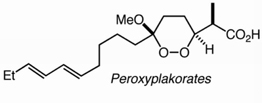Department of Chemistry
Date of this Version
2012
Citation
J Antimicrob Chemother. 67(8): 1979-1986
Abstract
Objectives: Compounds characterized by a peroxidic skeleton are an interesting starting point for antischistosomal drug discovery. Previously a series of 3-alkoxy-1,2-dioxolanes, which are chemically stable cyclic peroxides, demonstrated significant in vitro activity against Plasmodium falciparum. We aimed to evaluate the potential of these compounds against Schistosoma mansoni and elucidate the roles of iron and peroxidic groups in activity.
Methods: Drugs were tested against juvenile and adult stages of S. mansoni in vitro and in vivo. Selected structures were assessed in vitro against schistosomes in the presence of additional iron sources. In addition, drugs were tested in vitro and in vivo against Echinostoma caproni, a non-blood-feeding intestinal fluke. Finally, the activity of non-peroxidic analogues was evaluated.
Results: Three dioxolanes displayed IC50s ≤20.1 μM against adult schistosomes and values as low as 4.2 μM against newly transformed schistosomula. Nonetheless, only moderate, nonsignificant worm burden reductions were observed after treatment of mice harbouring adult infections. Drugs lacked activity against juvenile schistosomes in vivo. Two selected dioxolanes showed in vitro activity against E. caproni down to concentrations of 5 mg/L, but none of the compounds revealed in vivo activity. All tested non-peroxidic analogues lacked activity in vitro against both parasites.
Conclusions Selected dioxolanes presented interesting in vitro activity, but low in vivo activities have to be overcome to identify a lead candidate. Although the inactivity of non-peroxidic analogues underlines the necessity of a peroxide functional group, incubation of adult schistosomes with additional iron sources did not alter activity, supporting an iron-independent mode of activation.


Comments
Copyright © The Author 2012.